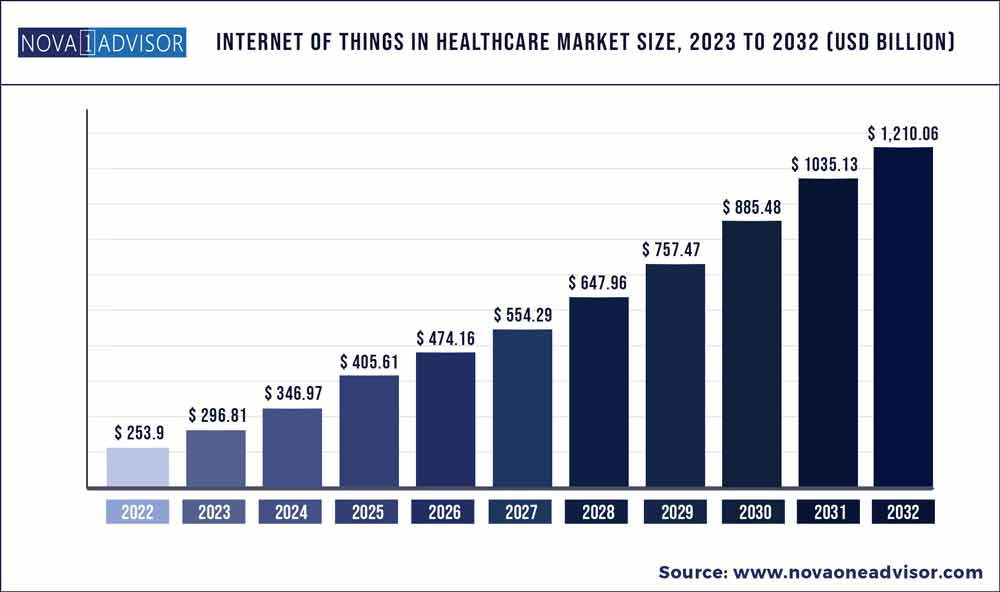The global internet of things in healthcare market size was exhibited at USD 253.9 billion in 2022 and is projected to hit around USD 1,210.06 billion by 2032, growing at a CAGR of 16.9% during the forecast period 2023 to 2032.

Key Pointers:
- In 2022, North America dominated the internet of things in healthcare market with a share of 45.2%.
- Asia Pacific is anticipated to witness the fastest growth over the forecast period.
- By component, the medical devices segment held the largest share of 38.1% in 2022.
- The system & software segment is anticipated to exhibit a rapid CAGR during the forecast years.
- By connectivity technology, the cellular segment held the largest share of 23.1% in 2022.
- The LPWANs segment is expected to witness rapid growth over the forecast period.
- By application, the telemedicine segment held the largest share of 32.9% in 2022.
- The patient monitoring segment is anticipated to witness rapid growth over the forecast period.
- The hospitals and clinics segment captured the highest revenue share of 56.1% in 2022.
- The clinical research organizations (CROs) segment is anticipated to expand at a significant pace with a CAGR of 17.1%.
Internet of Things in Healthcare Market Report Scope
The market is driven by the increasing usage of smartphones, smart devices, and wearables to monitor patients. Also, the increasing adoption of remote patient monitoring for improved out-of-hospital care boosts the market. Along with this, rising investments in implementing digital technologies in healthcare institutions, and the emergence of connected care are the key factors boosting industry growth. Technological advancements and the growing geriatric population coupled with the rising prevalence of chronic conditions are also positively impacting the market expansion.
High penetration of smartphones is one of the significant factors boosting the growth of the market. As per the statistics published in GSM Association’s report, The Mobile Economy 2018, the number of people connected to mobile services surpassed 5 billion in 2017 and the number of unique mobile subscribers is expected to reach 7.11 billion by 2032 (72% of the global population).
There is rising awareness among people for self-health monitoring and diagnosis due to the increase in the burden of various health issues at the early component of life. Rising awareness regarding healthy lifestyles among the young and adult population to adopt smart wearables to remotely monitor health activities and track them and monitor health issues is driving the market growth. Furthermore, many companies and healthcare institutions are launching mHealth programs for remote patient monitoring, which is leading to an increase in the adoption of IoT solutions for remote patient monitoring services.
Technological advancements in healthcare IT infrastructure, including the use of IoT, AI, and big data are one of the key factors boosting the market growth. Moreover, the growing demand for efficient & effective treatment and increasing awareness among patients about upgraded technology are also some of the factors expected to boost the internet of things in the healthcare market over the forecast period. Advanced technologies, such as smart sensors, robotic pills, microcontroller, digital networking, automotive microcontrollers, radiofrequency, and sensors, play a significant role in driving the market.
Rise in healthcare spending across the globe is driving the demand for the implementation of IoT solutions in the healthcare sector. According to estimates published by WHO in 2020, global spending on healthcare witnessed a significant surge, accounting for 11% of the global GDP or USD 9 trillion. The healthcare industry is evolving from fee-for-service model to value-based model, wherein treatment outcomes are reimbursed. The pressure of reducing healthcare costs is escalating globally as its cost is increasing faster than the growth of economies.
Furthermore, IoT solutions-enabled clinical trials also offer an opportunity for cost reduction as IoT simplifies the overall process and captures sophisticated endpoints. Remote patient monitoring solutions help in handling of noncritical patients at home, which eventually reduces hospital admissions and improves workflow efficiency. In addition, IoT solutions also enhance clinical operations through asset tracking and improvement in data capturing helping in significant cost savings. Thus, the demand for the development of the internet of things in healthcare is rising globally.
Some of the prominent players in the Internet of Things in Healthcare Market include:
- Medtronic
- Cisco Systems, Inc.
- IBM Corporation
- GE Healthcare
- Microsoft Corporation
- SAP SE
- Infosys Limited
- Cerner Corporation
- QUALCOMM Incorporated
- Amazon
- Intel corporation
- Wipro ltd
Segments Covered in the Report
This report forecasts revenue growth at global, regional, and country levels and provides an analysis of the latest industry trends in each of the sub-segments from 2018 to 2032. For this study, Nova one advisor, Inc. has segmented the global Internet of Things in Healthcare market.
By Component
- Medical Devices
- Wearable External Devices
- Implanted Medical Devices
- Stationary Medical Devices
- System and Software
- Remote Device Management
- Network Bandwidth Management
- Data Analytics
- Application Security
- Network Security
- Services
- System Integration Services
- Consulting, Training, and Education
- Support and Maintenance Services
By Connectivity Technology
- Cellular
- Wi-Fi
- Bluetooth
- LPWANs
- Zigbee
- RFID
By Application
- Telemedicine
- Patient Monitoring
- Connected Imaging
- Clinical Operations
- Medical Management
- Others
By End-use
- Hospitals and Clinics
- Clinical Research Organizations
- Research and Diagnostic Laboratories
- Others
By Region
- North America
- Europe
- Asia-Pacific
- Latin America
- Middle East & Africa (MEA)

